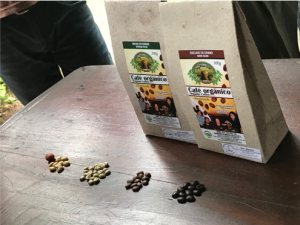By: Alizah Garvin and Kiara Bussey

We toured an organic coffee farm a short distance from campus in the forest few weeks of the semester. The coffee farm is owned by Odemar who prides himself on making organic shade grown coffee. The land was given to his family by the Quakers under the conditions that they maintain the land and its natural resources. Most of the farms do not use chemicals or fertilizers and they were certified as organic farmers after completing a 3-year process. So far they have planted 18,000 trees in the area and even installed irrigations systems. Odemar’s farm was the most reforested out of all the land that was given. His coffee farm uses the surrounding environment to protect the plants against pests. He plants fruit trees in close proximity to the coffee plants in order to give predators an alternative food source. The surrounding birds will also eat the pests off the plants, preventing disease. Pollinators include bees, bats, wasps, birds, and the wind therefore it’s in the coffee farms best interest to plant trees around the coffee and attract these pollinators. Without these protections the coffee plants are more susceptible to diseases such as la broca, ojo de gallo, rolla, and fungal infections.
We also learned a lot about how the coffee is made out of the coffee seeds. Odemar showed us around his coffee farm and explained each step of the coffee process as well as the agricultural difficulties he faces. The harvest season is from October to February but the peak month is December. They are harvested by hand on average 8 hours per day. The harvested is stored in the parchments stage during the off season because it will remain 
fresh in this stage for months. The ideal coffee seed is complete red before harvesting for better quality coffee. The coffee beans are weighed and then separated from the husk (outer shell). After that they are laid out in the sun to dry for 25 days and once dry and golden they are ready to roast! J If you want dark roast they leave it in there for 30 minutes and if you want medium roast you leave it in for only 25 minutes. The dark roast has less caffeine but a more bitter taste. If you would like honey roast they do not remove the husk and dry it in its ripe form; this process takes longer but results in a sweeter flavor. Once its ready the coffee is packaged in recycled paper and husk from the actual coffee seed.
At the end of the tour Odemar and his wife were really nice and invited us into their home to give us all fresh coffee. The coffee was amazing I usually don’t like coffee but it was really good. He could only speak Spanish but that did not take away from the experience at all. Overall, the tour was great and it was interesting to see the actual process of how organic coffee is made. 
